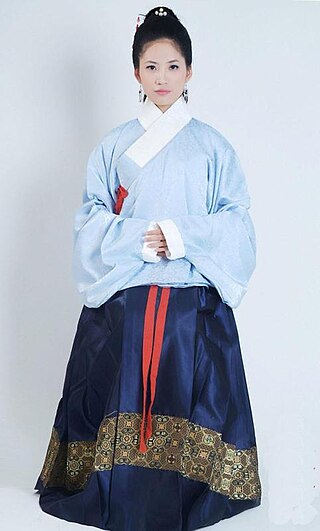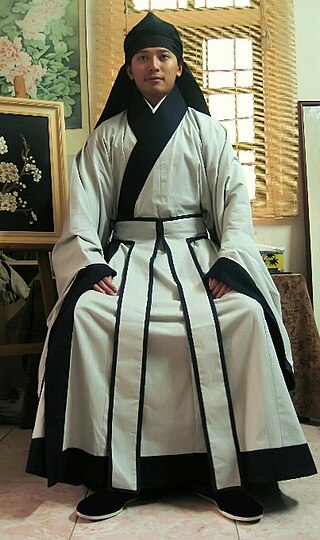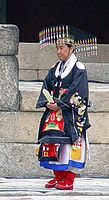- Yi Won wearing myeonbok
- Japan Emperor Kōmei's Mianfu (冕服
- Emperor Go-Sanjō in benpuku (冕服)
- Enthronement ceremony of Emperor Kōmei, benpuku (冕服) was used as ceremonial clothes.
- Paintings of Cổn miện costumes in the Nguyễn dynasty by Nguyễn Văn Nhân
This article needs additional citations for verification .(December 2015) |
 Painting of Wanli Emperor of the Ming dynasty wearing mianfu | |
| Type | Traditional imperial robe as part of hanfu |
|---|---|
| Place of origin | Shang dynasty, China |
| Introduced | Liao dynasty, Jin dynasty (1115–1234), Korea (at least since 1065 AD), Japan, Vietnam. Yuan Dynasty |
The dress of dukes (gong 公) resembles that of the emperor at or below the grade of gunmian 衮冕; the dress of marques (hou 侯) and earls (bo 伯) resembles that of the dukes at or below the grade of bimian 鷩冕; the dress of viscounts (zi 子) and barons (nan 男) resembles that of marques and earls at or below the grade of cuimian 毳冕; the dress of solitaries (gu 孤) resembles that of viscounts and baron at or below the grade of ximian 絺冕; the dress of ministers (qing 卿) and grand masters (dafu 大夫) resembles that of solitaries at or below the grade of xuanmian 玄冕.
— Translated by Zhang Fa (2015), in the book "The History and Spirit of Chinese Art", volume 1, translated from the original text, Zhouli
Though the use of mianfu was abolished during the Qin dynasty, in favour of a black shenyi called junxuan(袀玄) and tongtianguan , [7] [8] which was continued to be used throughout the Western Han dynasty, the mianfu and mianguan were later restored by Emperor Ming of Han in the Eastern Han dynasty based on Rites of Zhou and Confucian Classic of Rites. [9]
In the Song dynasty, the emperor wore mianfu which included: daqiumian and gunmian. [10] : 2 The crown prince of the Song dynasty also wore gunmian. [10] : 2 The rulers of the Jurchen-led Jin dynasty also created their own carriages and apparel system by adopting the clothing system of the Han people and by imitating the Song dynasty; and the Jin emperors wore gunmian. [10] : 41, 58 According to the Yuanshi, Möngke wore the gunmian in 1252. [11] : 45
After the Manchu conquerors established the Qing dynasty, the new government initiated a policy that forbade Han Chinese to wear Hanfu. Qing emperors did not use Mianfu as the emperor's official garb, which eventually resulted in this style of clothing disappearing from use.
Influence and derivatives
Due to the strong cultural influence China exerted on its neighbours, Mianfu was also worn by rulers in other East Asian countries that belonged to the so-called Sinosphere, such as Korea (in the form of myeonbok), Japan (known as Raifuku [12] ) and Vietnam (known as Cổn Miện) during the imperial era.
See also
Related Research Articles

Bianfu is a historical set of attire in Hanfu consisting of a knee-length Chinese upper garment known as jiangshapao over a qun, a Chinese skirt, known as hongchang or pair of ku-trousersalong with other accessories. Coupled with the Chinese headwear known as pibian, the complete set of attire is also referred as pibianfu. This set of attire was considered to be a ceremonial dress. In the Zhou dynasty, the bianfu was only ranked-second after the mianfu and it was worn by the emperors when he would work on official business or when he would meet with the court officials.

The academic dress of China has a long history. The ancient dress is based on the robes of officialdom and the 'degrees' were earned through the imperial civil service examinations, while the modern dress is partially influenced by the Western academic dress. Ancient China consisted of official dress. Official dress was used to represent an official in society and a scholar at the same time.

The mianguan, also called benkan in Japan, myeonlyugwan in Korea, and Miện quan in Vietnam, is a type of crown traditionally worn by the emperors of China, Japan, Korea, and Vietnam, as well as other kings in the East Asia.

Gwanbok is a Sino-Korean term derived from the terms guanfu and guanfu. The term gwanbok is a collective term which refers to historical official attire, which was bestowed by the government court, including Chinese courts of various dynasties. The guanfu (冠服) system was a court attire system in China which also formed part of the Hanfu system. This system was them spread to neighbouring countries and was adopted in Korea since ancient times in different periods through the ritual practice of bestowal of clothing. Acknowledgement through bestowed robes and crowns (冠服) from the Emperor of China, who held hegemony over East Asia, would give support to Korean Kings and successors, as being the authentic rulers of their country as well as confirmed the political status of the Korean kingdom in the rest of the Sinosphere. The gwanbok system in Korea was different for each kingdom and changed throughout different periods. For example, initially given by the Chinese court in ritual practice, successive gwanbok were more often than not locally manufactured in Korea with different colours and adopted into hanbok. The gwanbok, which was used as the uniform of court officials, formed part of the gwanbok system and was used like the suit is nowadays.

Ruqun is a set of attire in Hanfu which consists of a short jacket typically called ru worn under a long Chinese skirt called qun. However, when use as a general term, ruqun can broadly describe a set of attire which consists of a separated upper garment and a wrap-around lower skirt, or yichang, in which yi means the "upper garment" and the chang means the "lower garment". In a broad sense, ruqun can include the shanqun and aoqun in its definition.
A yuanlingshan is a type of round-collared upper garment in the traditional Chinese style of clothing known as Hanfu; it is also referred to as a yuanlingpao or a panlingpao when used as a robe. The yuanlingshan and yuanlingpao were both developed under the influence of ancient Chinese clothing, known as Hufu, originating from the Donghu people during the early Han dynasty and later by the Wuhu, including the Xianbei people, during the Six Dynasties period. The yuanlingpao is an article of formal attire primarily worn by men, although in certain dynasties, such as the Tang dynasty, it was also fashionable for women to wear. In the Tang dynasty, the yuanlingpao could be transformed into the fanlingpao using buttons.

Shenyi, also called Deep garment in English, means "wrapping the body deep within the clothes" or "to wrap the body deep within cloth". The shenyi is an iconic form of robe in Hanfu, which was recorded in Liji and advocated in Zhu Xi's Zhuzi jiali《朱子家禮》. As cited in the Liji, the shenyi is a long robe which is created when the "upper half is connected to the bottom half to cover the body fully". The shenyi, along with its components, existed prior to the Zhou dynasty and appeared at least since the Shang dynasty. The shenyi was then developed in Zhou dynasty with a complete system of attire, being shaped by the Zhou dynasty's strict hierarchical system in terms of social levels, gender, age, and situation and was used as a basic form of clothing. The shenyi then became the mainstream clothing choice during the Qin and Han dynasties. By the Han dynasty, the shenyi had evolved into two types of robes: the qujupao and the zhijupao. The shenyi later gradually declined in popularity around the Wei, Jin, and Northern and Southern dynasties period. However, the shenyi's influence persisted in the following dynasties. The shenyi then became a form of formal wear for scholar-officials in the Song and Ming dynasties. Chinese scholars also recorded and defined the meaning of shenyi since the ancient times, such as Zhu Xi in the Song dynasty, Huang Zongxi in the Ming dynasty, and Jiang Yong in the Qing dynasty.

Diyi, also called known as huiyi and miaofu, is the historical Chinese attire worn by the empresses of the Song dynasty and by the empresses and crown princesses in the Ming Dynasty. The diyi also had different names based on its colour, such as yudi, quedi, and weidi. It is a formal wear meant only for ceremonial purposes. It is a form of shenyi, and is embroidered with long-tail pheasants and circular flowers. It is worn with guan known as fengguan which is typically characterized by the absence of dangling string of pearls by the sides. It was first recorded as Huiyi in the Zhou dynasty.

Myeonbok is a kind of ceremonial clothing worn by the kings of Joseon Dynasty (1392–1910) in Korea. Myeonbok was adopted from Chinese Mianfu, and is worn by kings at special events such as the coronation, morning audience, Lunar New Year's audience, ancestral rites at Jongmyo and the soil and grain rite at Sajikdan. Myeonbok symbolizes the dignity of king when conducting important ceremonies.

Hanfu are the traditional styles of clothing worn by the Han Chinese since the 2nd millennium BCE. There are several representative styles of hanfu, such as the ruqun, the aoqun, the beizi and the shenyi, and the shanku.

Zaju chuishao fu, also called Guiyi, and sometimes referred as "Swallow-tailed Hems and Flying Ribbons clothing" or "swallow tail" clothing for short in English, is a form of set of attire in hanfu which was worn by Chinese women. The zaju chuishao fu can be traced back to the pre-Han period and appears to have originated the sandi of the Zhou dynasty; it then became popular during the Han, Cao Wei, Jin and Northern and Southern dynasties. It was a common form of aristocratic costumes in the Han and Wei dynasties and was also a style of formal attire for elite women. The zaju chuishao fu can be further divided into two categories of clothing style based on its cut and construction: the guipao, and the guichang.

Jisün, also known as zhisunfu or Zhisun, zhixun, jixun, zhama or Jisun, was a very important male Mongol garment during the Yuan dynasty. They were also known as Mongol "robes of honour" (khil'at). The zhisun was a form of ceremonial clothing, which was worn during the jisün banquets, which were the most important ceremony of the Yuan dynasty court. The zhisun were made of textile woven with gold and silk of one colour. In China, the zhisun was introduced during the Yuan dynasty and was inherited by the Han Chinese during the Ming dynasty. In both the Yuan and Ming dynasty, the zhisun is a single-coloured court robe. The zhisun is a type of Mongol terlig.

Bixi, also known as fu, is generic term which refers to a type of traditional Chinese decorative piece of fabric, which acts as a knee covering, in Hanfu. The bixi originated in China where it originated from the primitive clothing of the ancient; since then, it continued to be worn by both men and women, and eventually became part of the Chinese ceremonial attire. The bixi was later introduced in Korea during Goryeo and Joseon by the Ming dynasty, along with many garments for royalties.

Feiyufu, also called feiyu mangyi, is a type of traditional Han Chinese clothing which first appeared in the Ming dynasty. It is also specific name which generally refers to a robe decorated with the patterns of flying fish. The feiyufu worn by the Ming dynasty imperial guards reappeared in the 21st century following the hanfu movement and is worn by Hanfu enthusiasts of both genders.

Tongtianguanfu is a form of court attire in hanfu which was worn by the emperor during the Song dynasty on very important occasions, such as grand court sessions and during major title-granting ceremonies. The attire traces its origin from the Han dynasty.It was also worn in the Jin dynasty emperors when the apparel system of the Song dynasty was imitated and formed their own carriages and apparel system, and in the Ming dynasty. The tongtianguanfu was composed of a red outer robe, a white inner robe, a bixi, and a guan called tongtianguan, and a neck accessory called fangxin quling.

Xuanduan, also known as yuanduan, is a form of Chinese court dress which was made of dark or black fabric. It is a form of yichang. It was worn since the Western Zhou dynasty. During the Ming dynasty, under the reign of Emperor Jiajing, the xuanduan became a model for the regulations reforms related to yanfu worn by the emperor and officials.

Qizhuang, also known as Manfu and commonly referred as Manchu clothing in English, is the traditional clothing of the Manchu people. Qizhuang in the broad sense refers to the clothing system of the Manchu people, which includes their whole system of attire used for different occasions with varying degrees of formality. The term qizhuang can also be used to refer to a type of informal dress worn by Manchu women known as chenyi, which is a one-piece long robe with no slits on either sides. In the Manchu tradition, the outerwear of both men and women includes a full-length robe with a jacket or a vest while short coats and trousers are worn as inner garments.

Tanling ruqun, also known as Tan collar ruqun and U-collar ruqun, is a type of Hanfu which was developed under the influence of Hufu ; it is a form a kind of ruqun which typically consists of three parts, featuring a low-cut low-cut U-shaped collar upper inner garment with long sleeves, a U-shaped collar banbi upper outer garment with short sleeves, a long high-waisted skirt. It can also be adorned with a shawl, called pipo. It was a popular form of clothing attire in the Sui and Tang dynasty. In the 21st century, the Tanling ruqun re-appeared as a result of the Hanfu movement. The 21st century Tanling ruqun was developed by reproducing the original patterns of the historical tanling ruqun while being aligned with modern aesthetics.

The benkan is a type of crown traditionally worn by Japanese emperors and crown princes. It is also called tama no kōburi.
Guan, literally translated as hat or cap or crown in English, is a general term which refers to a type of headwear in Hanfu which covers a small area of the upper part of the head instead of the entire head. The guan was typically a formal form of headwear which was worn together with its corresponding court dress attire. There were sumptuary laws which regulated the wearing of guan; however, these laws were not fixed; and thus, they would differ from dynasty to dynasty. There were various forms and types of guan.
References
- 1 2 3 4 5 6 7 8 Zhang, Fa (2016). History and spirit of chinese art. Volume 1, From prehistory to the Tang dynasty. Honolulu: Silkroad Press. ISBN 978-1-62320-126-5. OCLC 933441686.
- 1 2 Gu, Weilie (2022). A GENERAL INTRODUCTION TO CHINESE CULTURE. Translated by Sun, Lixin. American Academic Press. ISBN 9781631815379.
- 1 2 3 Kwon, Cheeyun Lilian (2019). Efficacious underworld : the evolution of Ten Kings paintings in medieval China and Korea. Honolulu. ISBN 978-0-8248-5603-8. OCLC 1098213341.
{{cite book}}: CS1 maint: location missing publisher (link) - 1 2 3 4 5 6 7 8 9 Hua, Mei; 华梅 (2004). Zhongguo fu shi (Di 1 ban ed.). Beijing: Wu zhou chuan bo chu ban she. pp. 16–18. ISBN 7-5085-0540-9. OCLC 60568032.
- ↑ "Gujangbok: Ceremonial Robe Symbolizing the King's Prestige | Curator's Picks". NATIONAL MUSEUM OF KOREA. Retrieved 2022-10-13.
- ↑ (Chinese)陳邦懷,《殷代史料徵存》,鄴中片羽三集卷。
- ↑ "120". Book of Later Han.
"秦以戰國即天子位,滅去禮學,郊祀之服皆以袀玄。漢承秦故。"
- ↑ "25". Book of Jin.
"通天冠,本秦制。高九寸,正竖,顶少斜却,乃直下,铁为卷梁,前有展筒,冠前加金博山述,乘舆所常服也。 "
- ↑ "120". Book of Later Han.
显宗遂就大业,初服旒冕,衣裳文章,赤舄絇屦,以祠天地,养三老五更于三雍,于时致治平矣。
"2". Book of Later Han."二年春正月辛未,宗祀光武皇帝於明堂,帝及公卿列侯始服冠冕、衣裳、玉佩、絇屨以行事
- 1 2 3 Zhu, Ruixi; 朱瑞熙 (2016). A social history of middle-period China : the Song, Liao, Western Xia and Jin dynasties. Bangwei Zhang, Fusheng Liu, Chongbang Cai, Zengyu Wang, Peter Ditmanson, Bang Qian Zhu (Updated ed.). Cambridge, United Kingdom. ISBN 978-1-107-16786-5. OCLC 953576345.
{{cite book}}: CS1 maint: location missing publisher (link) - ↑ Shea, Eiren L. (2020). Mongol court dress, identity formation, and global exchange. New York, NY. ISBN 978-0-429-34065-9. OCLC 1139920835.
{{cite book}}: CS1 maint: location missing publisher (link) - ↑ Yu, A. C. "Raifuku (the Imperial Court) - Japanese Wiki Corpus". www.japanese-wiki-corpus.org. Retrieved 2022-08-07.
| Mianfu | |||||||
|---|---|---|---|---|---|---|---|
| Chinese name | |||||||
| Chinese | 冕服 | ||||||
| Literal meaning | Coronation clothing | ||||||
| |||||||
| Characteristics |
| ||||||||||||||||||
|---|---|---|---|---|---|---|---|---|---|---|---|---|---|---|---|---|---|---|---|
| Garments |
| ||||||||||||||||||
| Headwear (list) | |||||||||||||||||||
| Footwear (list) | |||||||||||||||||||
| Accessories (list) |
| ||||||||||||||||||
| Influenced clothing | |||||||||||||||||||
| Cosmetics | |||||||||||||||||||






